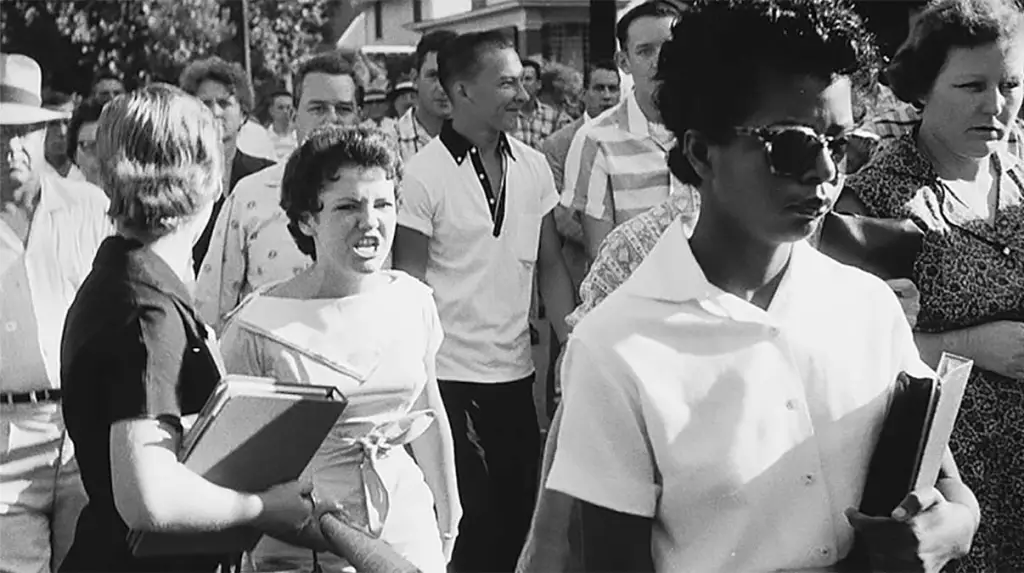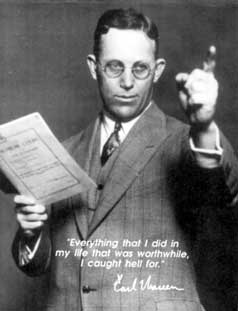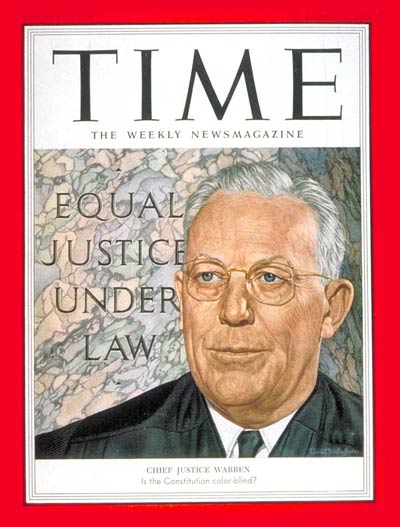SuperChief:
The Life and Legacy of Earl Warren
Academy Award nominated documentary
Revered and reviled, Supreme Court Chief Justice Earl Warren was considered by many to be the greatest Supreme Court Justice of all time. His historic rulings include bringing an end to legal segregation in public schools, creating the famous "Miranda Rights" to protect the accused, and establishing the one-person, one-vote principle that underlies all democracy.
Complex and controversial, his legacy also includes his decision as Governor of California to intern Japanese-Americans during World War 2.

Best Documentary
Academy Award Nomination
1989
Narrator
Gregory Peck
Directors
Bill Jersey
Judith Leonard
Edited by
Gary Weimberg
Written by
Bill Jersey
Judith Leonard
Gary Weimberg
Sharon Wood
Featuring
Justice William Brennan
Justice Warren Burger
Elizabeth Eckford
Gerald Ford
Justice Thurgood Marshall
Arthur Miller
Irving Stone
My
favorite scene
It is September, 1957.
It is the first day of school.
Elizabeth Eckford is one of the Little Rock Nine, a group of African-American school girls in Arkansas, who have decided to attend the previous all-white Central High School ... for the first time ever, as a direct result of the new Supreme Court Decision - Brown v Board of Education - which ended legal segregation in public schools.

2 1/2 minutes
As Chief Justice, Earl Warren's fingerprints are all over Brown v Board of Education decision that ended legal segregation in public schools in the USA. Famously. he coaxed a unanimous decision out of the previously very divided Supreme Court - making an unambiguous signal that there would be no going back to segregation.
This scene is where the rubber meets the road on such a great policy change, with the actual human beings whose lives embody the dangers and needs for such tremendous social transformation.
This clip is from during the editing process, not from the final version. So … consider it insider stuff.
The situation was:
They hired Mark Adler, a good friend of mine who is a wonderful composer, to create the music, . I had edited this very clip you see here, using a temporary piece of music, a place holder if you will, from another film, to suggest our musical intent – which was a very rhythmic music cue, more a pulsing beat than an actual melody.
At a couple key edits, i choose an abrasive, bold jump cut style to add visual impact to the scene. At each of those, I did the same to the temp music, sound cuts that deliberately broke the rhythm, creating audio jump cuts, totally out of beat, to accentuate the visual dissonance.
Mark hated it. He said it was … un-musical.
Despite my pleadings, his score for this scene was … in tempo and in time: a fine piece of music that always felt wrong to me, a missed opportunity for an important dramatic scene.
Well, his music is in the finished film. But I get the last word here. This clip includes the temp music and audio jump cuts. It never saw the light of day, nor left the editing room, until now.
(Sorry Mark. Not!)
BUT … fair warning …
Unfortunately, with temp music comes the temp narrator, who was … ahem … me. So, trigger alert, you will hear the younger Gary Weimberg as narrator on this clip.
The narrator for the finished piece? Oh, just some guy by the name of Gregory Peck.
So what you gain in music you lose in voice.
Dat’s show biz.
Film making … always a compromise.
To be clear, I was not nominated for an Oscar, nor was this a Luna Productions film. It was produced and directed by the talented Bill Jersey and Judith Leonard. They, and the film, were nominated for the Academy Award, 1989.
My role was editor and co-writer and Bill the director was one of the 3 great mentors in my professional life.
Bill is a seminal figure in the generation of documentary film makers who invented cinema verité, made possible by the invention of lighter-weight 16 mm cameras. The world opened up to their hand held pursuit of witnessing the truth. I am proud to call him a mentor and friend.
I first came to his attention because of the editing I’d done on the documentary Dear America: Letters from American Soldiers. After one particular screening of that profound and amazing film, Bill sought me out in the crowd and suggested he might have editing work for me.
His exact words were: “Send me a doo-dah.”
“A what?” I asked, totally confused.
“A doo-dah, you know, a resume or whatever …”
Cleverly, his next step was to do nothing. He didn’t call. He didn’t write. He didn’t hire me. But he did mention me to Marilyn Mulford, an independent film maker he was mentoring/supporting – including providing her with free editing room with the then state-of-the-art technology for editing – the Steenbeck flatbed film editing table.
Marilyn needed a new pair of hands on the machine and a new pair of eyes in the room.
She hired me, we finished her film together, and have been friends and collaborators ever since. Bill Jersey, meanwhile, got to watch me for 5 months and learn if he liked my work up-close and in depth, without paying a nickel. Smart guy!
Meanwhile, Superchief was brewing. It began with Judith Leonard, a lawyer who had an idea and wanted to be a film maker. As a first-timer she decided she needed an ultra-experienced partner. Smart gal! She came to Bill Jersey – presented the idea – a documentary on Earl Warren – and her willingness to raise money for it. In time, I joined their team and off we went – making a very worthwhile film about a very worthwhile man.
For Judy, this proved to be her dream come true. Her first film and she raised the money. She co-wrote the script. She got Gregory Peck to narrate. It got broadcast on PBS. It got rave reviews. Then it got nominated for an Oscar.
I said Judy, “Don’t get used to this. It isn’t always this easy.”
Post-post production note:
As for Judith Leonard and myself, we got along so well that we partnered up (professionally!) and though we didn’t know it then, we would spend most of the next 5 ish years facing some the of hardest and most wonderful moments in our lives as we made 3 primetime, network documentary specials together.
It began in the closing days of editing Superchief. “Got a moment, Judy?”
I brought her my idea for a documentary about the mother-daughter relationship. Step one, according to me, was doing 400 pre-interviews to identify the issues, themes and people to tell a truly diverse and profound and universal story of this core human relationship.
She went crazy for it.
She, Catherine Ryan and I became equal partners in a new company, Original Cinema; and off we went to sell The Story of Mothers and Daughters to ABC … and the world.

Everything that I did in my life that was worthwhile, I caught hell for."
- Earl Warren





